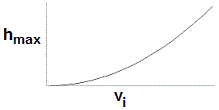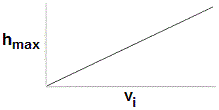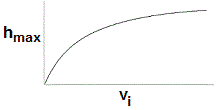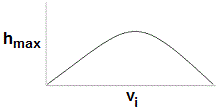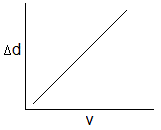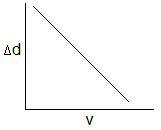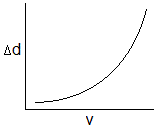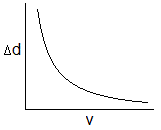|
| 1 |
Go |
Q:
|
An object's motion is depicted on a velocity versus time graph. Between t=2 seconds and t=5 seconds, the graph is decreasing linearly with a slope of -5. Which of the following describes the object's motion at t=3 seconds? |
|
A
|
The object's acceleration is decreasing. |
B
|
The object is stationary. |
C
|
The object is experiencing a positive acceleration. |
D
|
The object is experiencing a negative acceleration. |
|
|
|
Tags:
Kinematics | |
|
| 2 |
Go |
Q:
|
A cannonball with a mass of 10 kg is fired from a cannon and moves with an initial velocity of 100 meters per second at an angle of 60 degrees to the horizontal. After travelling a projectile path, the object lands in sand, displacing 36 liters of sand in its crater. Neglect air resistance and assume that g=10 m/s^2. What is the magnitude of the object's initial vertical veolocity? Note: sin(30)=0.5, cos(30)=0.866 |
|
A
|
25 m/s |
B
|
50 m/s |
C
|
87 m/s |
D
|
100 m/s |
|
|
|
Tags:
Kinematics | Quantitative Skills | |
|
| 3 |
Go |
Q:
|
The distance a car is away from the origin is given by the following equation: x=25t+3t^2. What is the acceleration at t=3 seconds? |
|
A
|
1 m/s^2 |
B
|
2 m/s^2 |
C
|
3 m/s^2 |
D
|
6 m/s^2 |
|
|
|
Tags:
Kinematics | Quantitative Skills | |
|
| 4 |
Go |
Q:
|
An object is pushed off of a cliff 17m high. If the cliff had been 34m high, how would the object's final velocity at the ground be affected? |
|
A
|
It would increase by a factor of √2 |
B
|
It would increase by a factor of 2 |
C
|
It would increase by a factor of 4 |
D
|
It would not be affected. |
|
|
|
Tags:
Kinematics | |
|
| 5 |
Go |
Q:
|
An object begins movement at 10 m/s and accelerates uniformly to 15 m/s. The distance that the object travels during acceleration is 40 m. What is the acceleration of the object? |
|
A
|
1.22 m/s2 |
B
|
1.56 m/s2 |
C
|
1.98 m/s2 |
D
|
2.5 m/s2 |
|
|
|
Tags:
Kinematics | |
|
| 6 |
Go |
Q:
|
A ball is thrown at a velocity v in the horizontal direction off of a building of heigh h. How far does the ball travel before hitting the ground? (assume that gravity=g)
|
|
A
|
2d/vg |
B
|
2dv |
C
|
v(2d/g) |
D
|
v(2d/g)1/2 |
|
|
|
Tags:
Kinematics | |
|
| 7 |
Go |
Q:
|
On its way down, a roller coaster of mass M travels at a velocity v. The roller coaster begins at a height h and goes over 3 smaller sized hills on its way to the bottom. What is v in terms of the other variables of the problem? (assume gravity=g)
|
|
A
|
(2gh)1/2 |
B
|
(2gh)1/2/3 |
C
|
2gh |
D
|
2gh/3 |
|
|
|
Tags:
Kinematics | |
|
| 8 |
Go |
Q:
|
A projectile is ejected at a velocity of 500 m/s with a horizontal component of 400 m/s. Neglecting air resistance, what will be the vertical component of the velocity upon hitting the ground, assuming it lands at th same elevation from which it was ejected?
|
|
A
|
300 m/s |
B
|
400 m/s |
C
|
500 m/s |
D
|
Not enough information is given to determine the terminal velocity |
|
|
|
Tags:
Kinematics | |
|
| 10 |
Go |
Q:
|
A car travels 90 meters due north in 15 seconds. Then the car turns around and travels 40 meters due south in 5.0 seconds. What is the magnitude of the average velocity of the car during this 20-second interval? |
|
A
|
2.5 m/s |
B
|
5.0 m/s |
C
|
6.5 m/s |
D
|
7.0 m/s |
|
|
|
Tags:
Kinematics | Quantitative Skills | |
|
| 12 |
Go |
Q:
|
A 1 kg object moves at 10 m/s across a level surface. The coefficient of kinetic friction is 0.50. How far will the object travel before it comes to a complete stop? Assume g = 10 m/s2. |
|
A
|
5 m |
B
|
10 m |
C
|
12.5 m |
D
|
20 m |
|
|
|
Tags:
Kinematics | |
|
| 13 |
Go |
Q:
|
A rock is thrown horizontally off of a cliff at 15 m/s. The cliff is 200 m above a river. About how long will it take the rock to land in the river? |
|
A
|
2 sec |
B
|
4 sec |
C
|
6 sec |
D
|
8 sec |
|
|
|
Tags:
Kinematics | Quantitative Skills | |
|
| 14 |
Go |
Q:
|
A fluid moves through a tube of diameter 10 with a speed v. The fluid continues flow, and reaches a different section of the tube which has diameter 20. What is the velocity through this section of tubing? |
|
|
|
|
Tags:
Kinematics | Fluids | Quantitative Skills | |
|
| 15 |
Go |
Q:
|
The New Year's Eve Ball in Times Square begins at a height H above the ground. The ball takes T seconds to make its way down (assuming freefall with negligible air resistance). If the gravitational force on Earth were reduced by four, how long would it take for the ball to make its way down? |
|
|
|
|
Tags:
Kinematics | Quantitative Skills | |
|
| 16 |
Go |
Q:
|
Given gravitational force as F = G*M*m/r2
where G is the gravitational constant, M is the mass of
one object, m is the mass of the other object, and r is the
distance between their center of masses, what is the
expression for gravitational acceleration of an object at
distance r? |
|
A
|
G*M/r2 |
B
|
M*m/r2 |
C
|
G*M*m/r |
D
|
G*M*m*r2 |
|
|
|
Tags:
Kinematics | |
|
| 17 |
Go |
Q:
|
The area under the curve of the velocity vs. time graph depicts |
|
A
|
instantaneous velocity |
B
|
average velocity |
C
|
acceleration |
D
|
distance traveled |
|
|
|
Tags:
Kinematics | Quantitative Skills | |
|
| 19 |
Go |
Q:
|
A rock is thrown horizontally off of a cliff at 15 m/s. The cliff is 200 m above a river. About how long will it take the rock to land in the river? |
|
A
|
2 sec |
B
|
4 sec |
C
|
6 sec |
D
|
8 sec |
|
|
|
Tags:
Kinematics | |
|
| 20 |
Go |
Q:
|
A block is accelerated from rest over a distance of 8 m with a net force of 4 N. The final velocity is 8 m/s. What is the mass of the block? |
|
A
|
3 kg |
B
|
2.5 kg |
C
|
1 kg |
D
|
0.5 kg |
|
|
|
Tags:
Kinematics | |
|
| 21 |
Go |
Q:
|
Two identical cars, one traveling at 26 mph and the other at 78 mph, skid to a stop. How much longer is the skid mark produced by the faster-moving car, assuming the skid mark begins forming immediately when the car begins decelerating, and end once the car is stationary? |
|
A
|
Both marks are equally long |
B
|
The faster car produced a mark 2 times longer. |
C
|
The faster car produced a mark 3 times longer. |
D
|
The faster car produced a mark 9 times longer. |
|
|
|
Tags:
Kinematics | |
|
| 22 |
Go |
Q:
|
Water flows through a cylindrical pipe. Initially, the water flows at 2.0 m/s in a section where the pipe radius is 6.0 m. The pipe then constricts to a pipe radius of 3.0 m. What is the water velocity through this section? Assume no friction. |
|
A
|
2 m/s |
B
|
4 m/s |
C
|
8 m/s |
D
|
16 m/s |
|
|
|
Tags:
Kinematics | Quantitative Skills | |
|
| 23 |
Go |
Q:
|
A particle has an initial velocity of 10 m/s and final velocity of 5 m/s. It travels 25 m. What is the acceleration of the particle assuming it is constant during the 25 meters traveled? |
|
A
|
1.5 m/s2 |
B
|
-0.10 m/s2 |
C
|
0.10 m/s2 |
D
|
-1.5 m/s2 |
|
|
|
Tags:
Kinematics | |
|
| 24 |
Go |
Q:
|
A particle is traveling at an initial velocity of 5 m/s. The particle accelerates over the next 10 s, at which time the particle displacement is 150 m. What is the acceleration of the particle? |
|
A
|
0.75 m/s2 |
B
|
1 m/s2 |
C
|
2 m/s2 |
D
|
3 m/s2 |
|
|
|
Tags:
Kinematics | |
|
| 25 |
Go |
Q:
|
A stationary ball is dropped from a height of 20 m. What is the speed of the ball just as it is about to hit the ground? Assume g = 10 m/s2 |
|
A
|
20 m/s |
B
|
25 m/s |
C
|
30 m/s |
D
|
40 m/s |
|
|
|
Tags:
Kinematics | |
|
| 26 |
Go |
Q:
|
A car begins at rest and accelerates at 2 m/s2. How long does the car take
to drive 400m?
|
|
A
|
20 s |
B
|
40 s |
C
|
80 s |
D
|
200 s |
|
|
|
Tags:
Kinematics | |
|
| 27 |
Go |
Q:
|
Ball A, with a mass of 10kg, and Ball B, with a mass of 20kg, were launched straight up into the air at the same speed. Neglect air resistance. Compared to Ball A, Ball B will: |
|
A
|
have greater acceleration |
B
|
return to the ground first |
C
|
travel a further distance |
D
|
experience equal acceleration |
|
|
|
Tags:
Kinematics | |
|
| 28 |
Go |
Q:
|
If Sally can bounce 5m in the air on a trampoline, how fast is she going when she reaches the trampoline? Assume g = 10 m/s2 |
|
A
|
4 m/s |
B
|
7 m/s |
C
|
10 m/s |
D
|
Cannot be determined from the given information. |
|
|
|
Tags:
Kinematics | Quantitative Skills | |
|
| 29 |
Go |
Q:
|
Bill jumps off a diving board 20 m off the ground. How long is he in the air before he hits the water? Assume g = 10 m/s2 |
|
A
|
1 second |
B
|
1.4 seconds |
C
|
2 seconds |
D
|
4 seconds |
|
|
|
Tags:
Kinematics | Quantitative Skills | |
|
| 30 |
Go |
Q:
|
The distance from the Earth to a satellite is 1.5 x 1015 meters. A radio signal is sent from the Earth to this satellite. How long would it take for the radio station on Earth to detect the returning signal from the satellite, from the time that it was first sent from Earth? Assume there is 0 time delay from the time the satellite receives the signal to the time it returns a signal. |
|
A
|
2 x 106 seconds |
B
|
5 x 106 seconds |
C
|
1 x 107 seconds |
D
|
5 x 105 seconds |
|
|
|
Tags:
Kinematics | Quantitative Skills | |
|
| 31 |
Go |
Q:
|
A ball is kicked vertically with a certain initial velocity and reaches a maximum height of 20 meters before falling again. What was the initial vertical velocity of the ball? |
|
A
|
10 m/s |
B
|
20 m/s |
C
|
40 m/s |
D
|
5 m/s |
|
|
|
Tags:
Kinematics | Quantitative Skills | |
|
| 32 |
Go |
Q:
|
A ball falls from a 10m cliff. It has reached terminal velocity 1 m from the ground. What is the ball's acceleration at this point? |
|
A
|
0 m/s2 |
B
|
1 m/s2 |
C
|
9 m/s2 |
D
|
10 m/s2 |
|
|
|
Tags:
Kinematics | Quantitative Skills | |
|
| 33 |
Go |
Q:
|
A car is traveling at a constant velocity of 30 m/s. If the driver suddenly brakes and decelerates at 5 m/s2, how far would the car travel before coming to a complete stop? |
|
A
|
60 meters |
B
|
90 meters |
C
|
180 meters |
D
|
15 meters |
|
|
|
Tags:
Kinematics | Quantitative Skills | |
|
| 34 |
Go |
Q:
|
A gust of wind blows a small potted plant off a windowsill. If the windowsill is 10 meters off of the ground, what is the approximate vertical speed of the plant when it hits the ground? |
|
A
|
5 m/s |
B
|
10 m/s |
C
|
14 m/s |
D
|
20 m/s |
|
|
|
Tags:
Kinematics | Quantitative Skills | |
|
| 35 |
Go |
Q:
|
A ball of mass 1 kg is dropped and reaches a final velocity of 3 m/s before hitting the ground. From what
height was the ball dropped?
|
|
A
|
0.45 m |
B
|
0.9 m |
C
|
1.4 m |
D
|
2 m |
|
|
|
Tags:
Kinematics | Quantitative Skills | |
|
| 36 |
Go |
Q:
|
If a ball is shot directly upwards with an initial velocity of 50 m/s, what is its displacement after 7
seconds? |
|
A
|
75 m |
B
|
105 m |
C
|
145 m |
D
|
175 m |
|
|
|
Tags:
Kinematics | Quantitative Skills | |
|
| 37 |
Go |
Q:
|

Object A chases Object B as in the diagram above. Object A emits a sound with a frequency of 1000 Hz. What is the frequency of sound heard by Object B if the velocity of sound is 350 m/s? |
|
A
|
880 Hz |
B
|
940 Hz |
C
|
1060 Hz |
D
|
1120 Hz |
|
|
|
Tags:
Kinematics | Sound | Quantitative Skills | |
|
| 38 |
Go |
Q:
|
When comparing the motion of a projectile through a fluid such as air, its distance traveled will be |
|
A
|
less than the distance traveled in a vacuum because friction predicts a loss of total energy to heat |
B
|
greater than the distance traveled because friction predicts a loss of total energy to heat |
C
|
less than the distance traveled in a vacuum because friction predicts a gain in total energy due to heat |
D
|
greater than the distance traveled because friction predicts a gain in total energy due to heat |
|
|
|
Tags:
Kinematics | Forces | |
|
| 39 |
Go |
Q:
|
A 5kg projectile is launched from the ground, reaches a maximum height of 100 m, and returns to the ground 1000m from where it was launched. How much time does it spend in the air? Neglect air resistance. |
|
A
|
2√5 seconds |
B
|
2√10 seconds |
C
|
4√5 seconds |
D
|
The answer cannot be determined with the given information |
|
|
|
Tags:
Kinematics | |
|
| 40 |
Go |
Q:
|
An object is thrown off a cliff at a height of 225 m with a horizontal velocity of 30 m/s. What is its horizontal distance traveled? |
|
A
|
100 m |
B
|
150 m |
C
|
200 m |
D
|
225 m |
|
|
|
Tags:
Kinematics | Quantitative Skills | |
|
| 41 |
Go |
Q:
|
A tank launches a rocket at a 30 degree angle. It takes a total of 20 seconds for the rocket to reach the ground from being launched. The horizontal component of velocity of rocket (when launched) is 30 m/s. Approximately how far did the rocket travel horizontally when the rocket is at maximal height? |
|
A
|
150 m |
B
|
233 m |
C
|
300 m |
D
|
375 m |
|
|
|
Tags:
Kinematics | Quantitative Skills | |
|
| 42 |
Go |
Q:
|
A cyclist accelerates at a constant rate from a resting state to 50 m/s. This acceleration takes place over a distance of 250 m. Which of the following is the acceleration experienced by the cyclist? |
|
A
|
5 m/s2 |
B
|
10 m/s2 |
C
|
15 m/s2 |
D
|
20 m/s2 |
|
|
|
Tags:
Kinematics | Quantitative Skills | |
|
| 43 |
Go |
Q:
|
The area under the curve of a velocity vs. time graph depicts the |
|
A
|
displacement of the object in motion. |
B
|
velocity of the object in motion. |
C
|
acceleration of the object in motion. |
D
|
impulse of the object in motion. |
|
|
|
Tags:
Kinematics | Quantitative Skills | |
|
| 44 |
Go |
Q:
|
How long does it take for a ball to drop if it is released from a height of 15 m off the ground? |
|
A
|
1.4 seconds |
B
|
1.5 seconds |
C
|
1.7 seconds |
D
|
3 seconds |
|
|
|
Tags:
Kinematics | Quantitative Skills | |
|
| 45 |
Go |
Q:
|
A car is decelerating at 5m/s2 from an initial velocity of 10m/s. What is the the total displacement when it comes to a stop? |
|
A
|
2 m |
B
|
5 m |
C
|
10 m |
D
|
20 m |
|
|
|
Tags:
Kinematics | Quantitative Skills | |
|
| 46 |
Go |
Q:
|
A paratrooper of mass M is falling through the sky. He is moving at constant velocity due to air resistance. If the force of air resistance is X and is then suddenly decreased 3-fold, which of the following represents his acceleration? |
|
A
|
X/3M |
B
|
2X/3M |
C
|
X/M |
D
|
3X/M |
|
|
|
Tags:
Kinematics | Quantitative Skills | |
|
| 47 |
Go |
Q:
|
Billy throws a ball to Sam, who is standing 5 m away. Which of the following statements is true? |
|
A
|
Billy must throw the ball faster than 10 m/s |
B
|
The ball reaches dynamic equilibrium at the peak of its flight |
C
|
The ball is never at equilibrium during its flight |
D
|
The ball has a kinetic energy of zero at the peak of its flight |
|
|
|
Tags:
Kinematics | |
|
| 48 |
Go |
Q:
|
A car accelerates steadily over 10 seconds from a stationary position to 25 m/s. The car maintains its velocity for 20 seconds, then decelerates steadily back to a stationary position in 5 seconds. What is its total displacement from start to finish? |
|
A
|
350 m |
B
|
437.5 m |
C
|
687.5 m |
D
|
875 m |
|
|
|
Tags:
Kinematics | Quantitative Skills | |
|
| 49 |
Go |
Q:
|
Which of the following expressions describes the amount of time it takes for a projectile to land at the same elevation from which it is emitted? Note: h indicates the maximum height reached and g is acceleration due to gravity. Neglect air resistance. |
|
A
|
2√(2gh) |
B
|
√(2h/g) |
C
|
2√(2h/g) |
D
|
2√(h/2g) |
|
|
|
Tags:
Kinematics | |
|
| 50 |
Go |
Q:
|
A projectile is fired from a cannon with a velocity of 400 m/s at an angle of 30° to the horizontal. If the cannon is instead moving at a horizontal velocity of 10 m/s (in the same direction as the projectile) when the projectile launches, how much farther will the projectile travel? Neglect air resistance. |
|
A
|
80 m |
B
|
400 m |
C
|
800 m |
D
|
28800 m |
|
|
|
Tags:
Kinematics | Quantitative Skills | |
|
| 51 |
Go |
Q:
|
A 2kg block slides from rest down a frictionless slide at an angle of 60° to the horizontal. If it takes 2 seconds to slide to the bottom, how far has the block traveled down the slide? |
|
A
|
5 m |
B
|
8.7 m |
C
|
17.3 m |
D
|
20 m |
|
|
|
Tags:
Kinematics | Quantitative Skills | |
|
| 52 |
Go |
Q:
|
A penny (1.7 g) is dropped off the roof of a 380m skyscraper. Nelgecting air resistance, how fast is the penny moving immediately before it hits the ground? |
|
A
|
44 m/s |
B
|
70 m/s |
C
|
87 m/s |
D
|
The answer cannot be determined with the given information. |
|
|
|
Tags:
Kinematics | Quantitative Skills | |
|
| 53 |
Go |
Q:
|
Ultrasonic distance detectors emit an ultrasonic frequency that bounces off of the opposing object and is picked up by the detector. The longer it takes for the sound to come back, the farther away it is. If the time between the sound emission and detection is 30 milliseconds, how far away is the object being measured? Note: assume the speed of sound is 350 m/s. |
|
A
|
5 m |
B
|
10 m |
C
|
50 m |
D
|
100 m |
|
|
|
Tags:
Kinematics | Sound | Quantitative Skills | |
|
| 54 |
Go |
Q:
|
A car decelerates from 30 m/s to 10 m/s in 5 seconds. How far did it travel during its deceleration? |
|
A
|
20 m |
B
|
100 m |
C
|
40 m |
D
|
400 m |
|
|
|
Tags:
Kinematics | Quantitative Skills | |
|
| 55 |
Go |
Q:
|
A series of experiments is conducted to measure how the maximum height an object will reach changes when its vertical launch velocity is changed. Which of the following graphs best depicts the relationship between the initial vertical velocity of the launched objects and their maximum height reached? |
|
|
|
|
Tags:
Kinematics | Quantitative Skills | |
|
| 56 |
Go |
Q:
|
How long does it take a car decelerating at 5 m/s2 from an initial velocity of 10 m/s to stop moving? |
|
A
|
1 sec |
B
|
1.4 sec |
C
|
2 sec |
D
|
2.7 sec |
|
|
|
Tags:
Kinematics | Quantitative Skills | |
|
| 57 |
Go |
Q:
|
A ball is kicked at an angle of 45° to the horizontal. What is its maximum height reached if its velocity when it lands is 25 m/s? Neglect air resistance. |
|
A
|
16 m |
B
|
25/√2 m |
C
|
31 m |
D
|
The answer cannot be determined with the given information |
|
|
|
Tags:
Kinematics | Quantitative Skills | |
|
| 58 |
Go |
Q:
|
Bill has a mass of 70kg and jumps off a platform at a height of 8m off the ground. At the same time, he throws a ball of 7kg straight outward in the horizontal direction. Neglecting air resistance, you would expect that the ball hits the ground |
|
A
|
before Bill. |
B
|
at the same time as Bill. |
C
|
after Bill. |
D
|
The answer cannot be determined from the given information. |
|
|
|
Tags:
Kinematics | |
|
| 59 |
Go |
Q:
|
The terminal velocity for an object falling through a fluid will decrease in all of the following circumstances EXCEPT: |
|
A
|
an increase in the fluid density |
B
|
an increase in the object's mass |
C
|
a decrease in the object's density |
D
|
an increase in the viscosity of the fluid |
|
|
|
Tags:
Kinematics | Fluids | |
|
| 60 |
Go |
Q:
|
Two objects start from rest at the same position and accelerate in the same direction. Object A accelerates at 2 m/s2 while Object B accelerates at 4 m/s2. At the end of 5 seconds, how much farther has Object B traveled than Object A? |
|
A
|
15 m |
B
|
25 m |
C
|
50 m |
D
|
75 m |
|
|
|
Tags:
Kinematics | Quantitative Skills | |
|
| 61 |
Go |
Q:
|
A 2kg projectile is shot at 60° to the horizontal with a velocity of 16 m/s. At the peak of its arc, what is its total kinetic energy? Neglect air resistance. |
|
A
|
8 J |
B
|
8√3 J |
C
|
64 J |
D
|
16√3 J |
|
|
|
Tags:
Kinematics | Energy & Work | Quantitative Skills | |
|
| 62 |
Go |
Q:
|
A 0.5kg projectile is launched 30° to the horizontal at 40 m/s. What is its total kinetic energy at the highest point of its path? Assume air resistance is negligible. |
|
A
|
8.7 J |
B
|
35 J |
C
|
300 J |
D
|
1200 J |
|
|
|
Tags:
Kinematics | Energy & Work | Quantitative Skills | |
|
| 63 |
Go |
Q:
|
A storm drain has a maximum capacity of 120 L/min. During heavy rains, an influx of 240 L/min approaches the drain. Assuming the the drain is cylindrical, by how much would the drain radius need to be increased to handle the heavier rainfall? Assume the water travels at the same linear speed in both drains. |
|
A
|
16 times greater |
B
|
42 times greater |
C
|
2 times greater |
D
|
1.4 times greater |
|
|
|
Tags:
Kinematics | Quantitative Skills | |
|
| 64 |
Go |
Q:
|
Assuming three identical blocks are released from the same height on frictionless inclines of differing angles, which block will be traveling fastest when it reaches the bottom? |
|
A
|
 |
B
|
 |
C
|
 |
D
|
All blocks will be traveling at the same speed when they reach the bottom. |
|
|
|
Tags:
Kinematics | Energy & Work | |
|
| 65 |
Go |
Q:
|

A cart with mass m is accelerated to a velocity v and collided with a spring as in the diagram above. Which of the following depicts the relationship between the maximum displacement of the spring upon collision and the velocity of the cart? |
|
|
|
|
Tags:
Kinematics | Forces | Quantitative Skills | |
|
| 66 |
Go |
Q:
|
A krypton fluoride laser can emit light in brief pulses of only 4 nanoseconds. Given the velocity of light in a vacuum is 3 x 108 m/s, how long is each pulse of light if emitted underwater? Note the index of refraction of water is 1.33. |
|
A
|
90 cm |
B
|
1.2 m |
C
|
1.6 m |
D
|
2.1 m |
|
|
|
Tags:
Kinematics | Fluids | Quantitative Skills | |
|
| 67 |
Go |
Q:
|
A 10 kg block is accelerated at 2 m/s2 up a frictionless plane inclined at 30 degrees to the horizontal. The force acting parallel to the plane pushing the block upwards is: |
|
A
|
100 N |
B
|
25 N |
C
|
50 N |
D
|
70 N |
|
|
|
Tags:
Kinematics | Forces | Quantitative Skills | |
|
| 68 |
Go |
Q:
|
An object in space masses 10,000 kg and accelerates from a velocity of 1500 m/s to 3500 m/s over the course of 50 seconds. How much work was done to accelerate the object? |
|
A
|
4 x 105 J |
B
|
5 x 1010 J |
C
|
1.25 x 105 J |
D
|
2 x 109 J |
|
|
|
Tags:
Kinematics | Energy & Work | Quantitative Skills | |
|
| 69 |
Go |
Q:
|
Theoretically, consider that a hole is dug through the surface of the Earth to the exact opposite side of the Earth (such that the hole passes through the precise center of the Earth). A ball is dropped into the hole. Which of the following holds true for acceleration (a) and velocity (v) of the ball when the ball makes its way to the center of the Earth (assume resistance due to air is zero)? |
|
A
|
a=0, v=0 |
B
|
|a|>0, v=0 |
C
|
a=0, |v|>0 |
D
|
|a|>0, |v|>0 |
|
|
|
Tags:
Kinematics | Forces | |
|
| 70 |
Go |
Q:
|
A rocket is traveling at 10 m/s and accelerates to 100 m/s at a rate of 10 m/s2. What, approximately, is the distance the rocket traverses from initial to final velocity? |
|
A
|
100m |
B
|
500m |
C
|
1000m |
D
|
1500m |
|
|
|
Tags:
Kinematics | Quantitative Skills | |
|
| 71 |
Go |
Q:
|
A car accelerates from 0 m/s to 100 m/s in 5 seconds. What distance does the car drive over to achieve this acceleration? |
|
A
|
100m |
B
|
150m |
C
|
200m |
D
|
250m |
|
|
|
Tags:
Kinematics | Quantitative Skills | |
|
| 72 |
Go |
Q:
|
A canon is fired at a 30 degree angle to the horizontal. At the top of its motion, which of the following is accurate? |
|
A
|
|velocity| = 0, |acceleration| = 0 |
B
|
|velocity| > 0, |acceleration| = 0 |
C
|
|velocity| > 0, |acceleration| > 0 |
D
|
|velocity| = 0, |acceleration| > 0 |
|
|
|
Tags:
Kinematics | |
|
| 73 |
Go |
Q:
|
Which of the following is the rate of flow of fluid traveling at 0.3 m/s through a lumen of cross-sectional diameter of 4 x 10-3 m? |
|
A
|
2 x 10-4 m3/s |
B
|
1.5 x 10-5 m3/s |
C
|
1.25 x 10-7 m3/s |
D
|
4 x 10-6 m3/s |
|
|
|
Tags:
Kinematics | Quantitative Skills | |
|
| 74 |
Go |
Q:
|
Air resistance is usually neglected for objects in motion, however it can be formalized to the equation F=-cv2, where c is the air constant and v is the velocity. Which of the following correctly states the relationship of the graphs of velocity over time for a free-falling object with and without air resistance? |
|
A
|
Without air resistance, the graph is linear. With air resistance, the graph is non-linear. |
B
|
Without air resistance, the graph is non-linear. With air resistance, the graph is linear. |
C
|
Both graphs will appear linear. |
D
|
Both graphs will appear non-linear. |
|
|
|
Tags:
Kinematics | |
|
| 75 |
Go |
Q:
|
A ball of weight 20N sits at the bottom of a 100m pool. Buoyancy force is calculated and is determined to be 30N. Approximately how long will it take for the ball to rise to the surface? |
|
A
|
4 seconds |
B
|
6 seconds |
C
|
8 seconds |
D
|
10 seconds |
|
|
|
Tags:
Kinematics | Forces | Quantitative Skills | |
|
| 76 |
Go |
Q:
|
A blood platelet is moving along through an artery that is partially blocked by deposits, though there is no accumulation or leakage of blood in the artery. Which of the following best describes the speed and pressure of the platelet as it moves from the narrow region (the region partially blocked by deposits) to the wider region? |
|
A
|
An increase in pressure, and an increase in speed |
B
|
An increase in pressure, and a decrease in speed |
C
|
A decrease in pressure, and no change in speed |
D
|
No change in pressure, and a decrease in speed |
|
|
|
Tags:
Kinematics | Quantitative Skills | |
|
| 77 |
Go |
Q:
|
A box sits atop a frictionless ramp and then from rest, slides down it, achieving some speed at the very bottom (before it hits the floor). For that same box to achieve a speed (at the bottom of the ramp) twice as fast as the original, how much taller should a new ramp be? |
|
A
|
The new ramp should be the same height as the original, but with a more gradual slope
|
B
|
The new ramp should be twice as high as the original
|
C
|
The new ramp should be three times higher than the original
|
D
|
The new ramp should be four times higher than the original
|
|
|
|
Tags:
Kinematics | Energy & Work | |
|
| 78 |
Go |
Q:
|
An ideal spring-loaded gun fires a plastic ball straight up into the air, reaching the maximum height possible, due to the spring being fully compressed. Assuming no friction, if the spring were only compressed half as far, what would be the height of the plastic ball compared to the original? |
|
A
|
Twice as high
|
B
|
Same height |
C
|
Half as high |
D
|
One fourth as high |
|
|
|
Tags:
Kinematics | Energy & Work | |
|
| 79 |
Go |
Q:
|
"Flour bombing" is a common activity at a lot of airfields where student pilots are learning to fly. It involves filling bags with flour, flying a plane over a marked target, and then dropping the bags to see who can get closest to the target. A student pilot is flying in level flight and must release the flour bag before it is over the target. Ignoring air resistance, which of the following is NOT correct? |
|
A
|
The acceleration of the flour bag is constant
|
B
|
The pilot will be over the target when the flour bag strikes
|
C
|
The flight time of the flour bag is independent of the horizontal speed of the plane
|
D
|
The horizontal velocity of the plane is equal to the vertical velocity of the flour bag when it hits the target
|
|
|
|
Tags:
Kinematics | Forces | |
|
| 80 |
Go |
Q:
|
An object is dropped in the absence of air resistance, so it accelerates downward at 9.8 m/s2. Which of the following is correct about its downward acceleration after release if that same object is thrown downward? |
|
A
|
The downward acceleration is greater than 9.8 m/s2
|
B
|
The downward acceleration is equal to 9.8 m/s2
|
C
|
The downward acceleration is less than 9.8 m/s2
|
D
|
The downward acceleration cannot be determined from the given information
|
|
|
|
Tags:
Kinematics | |
|
| 81 |
Go |
Q:
|
A tennis ball is launched upward at an angle from starting Point A. Point B is at the top of its parabolic trajectory (the highest position of the ball above the ground), and Point C is when it hits the ground. At which point in its trajectory is the ball's velocity vector changing most rapidly with respect to time? |
|
A
|
Point A |
B
|
A point between Point A and Point C
|
C
|
Point C |
D
|
The change in velocity is the same at any point in the trajectory
|
|
|
|
Tags:
Forces | Kinematics | |
|
| 82 |
Go |
Q:
|
Which of the following is true with respect to an object moving from one location (d1) to another (d2)? |
|
A
|
After reaching d2, the displacement is either greater than or equal to the distance traveled
|
B
|
After reaching d2, the displacement is either smaller than or equal to the distance traveled
|
C
|
After reaching d2, the displacement is always greater than the distance traveled
|
D
|
After reaching d2, the displacement is always equal to the distance traveled
|
|
|
|
Tags:
Kinematics | |
|
| 83 |
Go |
Q:
|
For a physics experiment, a graduate student stands on edge at the top of a building and throws one ball straight up and another ball straight down at the same initial speed. If air resistance is ignored, which of the following is correct? |
|
A
|
The ball to hit the ground with greater speed is the one initially thrown upward
|
B
|
The ball to hit the ground with greater speed is the one initially thrown downward
|
C
|
The ball to hit the ground with greater speed depends on the height of the ball thrown upward
|
D
|
Both balls hit the ground at the same speed
|
|
|
|
Tags:
Kinematics | |
|
| 84 |
Go |
Q:
|
The following graph shows the position vs. time for a train moving along a straight track. Which of the following is true? Note: position vs. time means the y-axis is position and the x-axis is time.
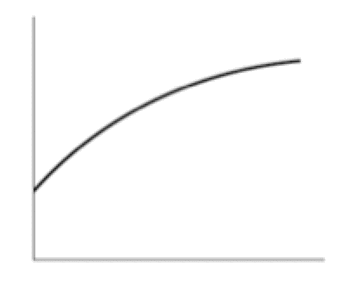 |
|
A
|
Based on the graph, the train speeds up the entire time
|
B
|
Based on the graph, the train moves at constant velocity
|
C
|
Based on the graph, the train slows down the entire time
|
D
|
Based on the graph, the train speeds up for part of the time and slows down for another part of the time
|
|
|
|
Tags:
Kinematics | |
|
| 85 |
Go |
Q:
|
Which of the following is correct in describing the act of throwing a ball straight up in the air? |
|
A
|
At its highest point, the ball's velocity is nonzero and its acceleration is zero
|
B
|
At its highest point, the ball's velocity is zero and its acceleration is nonzero
|
C
|
At its highest point, the ball's velocity and acceleration are both zero
|
D
|
At its highest point, the ball's velocity and acceleration are both nonzero
|
|
|
|
Tags:
Kinematics | |
|
| 86 |
Go |
Q:
|
A ship fires two projectiles with parabolic trajectories (assuming no air resistance) towards two different ships at the same time. Which of the following statements is correct?
 |
|
A
|
Ship A is hit first
|
B
|
Ship B is hit first
|
C
|
Both ships are hit at the same time
|
D
|
The answer cannot be determined with the given information
|
|
|
|
Tags:
Kinematics | |
|
| 87 |
Go |
Q:
|
A block of mass m slides down a hill of height h which makes a 30° angle with the horizontal. Assuming zero friction along the hill, what is the velocity of the block at the bottom of the hill? |
|
A
|
√(2gh)sin(30°) |
B
|
√(2gh)cos(30°) |
C
|
√(2gh) |
D
|
√(mgh) |
|
|
|
Tags:
Energy & Work | Kinematics | |
|
| 88 |
Go |
Q:
|
An object at rest accelerates at a rate of 500 m/s2 to a velocity of 85 m/s. Which of the following must be true of this scenario? |
|
A
|
The time of acceleration must be less than 1 s. |
B
|
The force of acceleration must be less than the force of gravity. |
C
|
The displacement of the object during acceleration must be less than 1 m. |
D
|
The object travels faster than its terminal velocity at the end of its acceleration. |
|
|
|
Tags:
Kinematics | |
|
| 89 |
Go |
Q:
|
A ball is thrown straight upwards into the air at a velocity of 10 m/s. Which of the following correctly states the approximate maximal height this ball will reach? |
|
|
|
|
Tags:
Kinematics | |
|
| 90 |
Go |
Q:
|
The graph of an object falling from the sky (in absence of air resistance) with y-axis as acceleration and x-axis as time would be expected to look like: |
|
A
|
a parabolic curve. |
B
|
a horizontal line. |
C
|
a line with positive slope. |
D
|
a line with negative slope. |
|
|
|
Tags:
Kinematics | |
|
| 91 |
Go |
Q:
|
A car accelerates from 2 m/s to 20 m/s along a road. The acceleration function is uniform and does not change during the acceleration phase. Which of the following holds true regarding the average velocity of the car? |
|
A
|
it would be equal to 11 m/s |
B
|
it would be greater than 11 m/s |
C
|
it would be less than 11 m/s |
D
|
unable to determine based on the information provided in the question stem. |
|
|
|
Tags:
Kinematics | |
|
| 92 |
Go |
Q:
|
A metal round object with a weight of 10 N is dropped from the top of a very tall skyscraper of height 2 km. In absence of air resistance, the greatest velocity that the object will attain during this fall would be expected to occur after falling: |
|
A
|
10 m |
B
|
50 m |
C
|
100 m |
D
|
>100 m |
|
|
|
Tags:
Kinematics | |
|
| 93 |
Go |
Q:
|
A car accelerates from 0 to 90 km/hr in 4 seconds. Which of the following represents the average acceleration of the car? |
|
A
|
22.5 km/hr2 |
B
|
9,000 km/hr2 |
C
|
22,500 km/hr2 |
D
|
81,000 km/hr2 |
|
|
|
Tags:
Kinematics | |
|
| 94 |
Go |
Q:
|
How far must a spring with a constant 1500 N/m be compressed to launch a 5kg object at a speed of 20 m/s? |
|
A
|
27 cm |
B
|
63 cm |
C
|
98 cm |
D
|
115 cm |
|
|
|
Tags:
Kinematics | |
|
| 95 |
Go |
Q:
|
A solar eclipse takes place such with numerous observers on Earth. During such an event, the moon perfectly aligns in front of the sun, thus eclipsing the sun and casting the Earth into darkness. A halo may form around the the eclipse which reflects light from the sun passing around the moon. Assuming the moon is a distance X from Earth and the sun is a distance Y from Earth, which of the following expressions reflects the amount of time it takes for light from the halo to reach an observer's eyes? Assume the speed of light is c. |
|
A
|
X/c |
B
|
Y/c |
C
|
X/2c |
D
|
Y/2c |
|
|
|
Tags:
Kinematics | |
|
| 96 |
Go |
Q:
|
An object accelerates from 1 m/s to 9 m/s over a distance of 600 km. Which of the following is the accleration experienced by the object? |
|
A
|
1/10,000 m/s2 |
B
|
1/15,000 m/s2 |
C
|
1/30,000 m/s2 |
D
|
1/35,000 m/s2 |
|
|
|
Tags:
Kinematics | |
|
| 97 |
Go |
Q:
|
An object travels from rest to the east at 15 m/s for 2 seconds. Then the object travels north at 15 m/s for 2 seconds. Which of the following is the displacement of the object? |
|
A
|
20 m |
B
|
30 m |
C
|
40 m |
D
|
50 m |
|
|
|
Tags:
Kinematics | |
|
| 98 |
Go |
Q:
|
A car accelerates from 15 m/s to 35 m/s in 2.5 seconds. What is the approximate distance traveled over this acceleration, assuming that the acceleration is constant? |
|
A
|
20 m |
B
|
40 m |
C
|
60 m |
D
|
80 m |
|
|
|
Tags:
Kinematics | |
|
| 99 |
Go |
Q:
|
The New Year's Eve ball descends from a height of 100m to 40m at a constant speed, approximately 1 meter per second for the last minute of the new year. Which of the following is correct regarding the descent? |
|
A
|
There are no forces acting on the ball. |
B
|
The ball only has forces acting on it in the downward direction. |
C
|
The ball has no velocity. |
D
|
The ball has zero acceleration. |
|
|
|
Tags:
Kinematics | |
|
| 100 |
Go |
Q:
|
A 40kg object is pushed with a constant force of 180 N over a distance of 1.2 m through an opposing frictional force of 20 N. What is work done on the package? |
|
A
|
192 J |
B
|
204 J |
C
|
216 J |
D
|
240 J |
|
|
|
Tags:
Kinematics | |
|
| 101 |
Go |
Q:
|
A 50kg object rests on a 45 degree incline. What coefficient of static friction would be required to keep the object from moving? |
|
|
|
|
Tags:
Kinematics | |
|
| 102 |
Go |
Q:
|
A paper airplane is launched at a 90 degree angle to the horizontal at 15 m/s and follows the basic properties of a projectile. What is the total horizontal distance flown? |
|
A
|
0 m |
B
|
18 m |
C
|
20 m |
D
|
22 m |
|
|
|
Tags:
Kinematics | |
|
| 103 |
Go |
Q:
|
A moving vehicle decelerates at a rate of 25 mm/s2 from a velocity of 100 m/s. How much time will be required for vehicle to stop? |
|
A
|
25 seconds |
B
|
40 seconds |
C
|
2500 seconds |
D
|
4000 seconds |
|
|
|
Tags:
Kinematics | |
|
| 104 |
Go |
Q:
|
Which of the following depicts the units of the coefficient of static friction for a block resting on the ground? |
|
A
|
unitless |
B
|
1/mass |
C
|
1/mass*distance |
D
|
distance/mass |
|
|
|
Tags:
Kinematics | |
|
| 105 |
Go |
Q:
|
A car traveling at 100 m/s must decelerate to standstill in 100m. What is the magnitude of the deceleration of the car? |
|
A
|
25 m/s2 |
B
|
50 m/s2 |
C
|
66 m/s2 |
D
|
100 m/s2 |
|
|
|
Tags:
Kinematics | |
|
| 106 |
Go |
Q:
|
Which of the following is true for an object without acceleration? |
|
A
|
it does not have velocity |
B
|
it must have a positive velocity |
C
|
it has no forces acting upon it |
D
|
it does not change direction |
|
|
|
Tags:
Kinematics | |
|
| 107 |
Go |
Q:
|
An object is dropped from a height X meters on a planet where the acceleration due to gravity is X m/s2. How much time will it take for the object to hit the ground? |
|
A
|
sqrt(2) seconds |
B
|
sqrt(2)/X seconds |
C
|
X*sqrt(2) seconds |
D
|
X seconds |
|
|
|
Tags:
Kinematics | |
|
| 108 |
Go |
Q:
|
What is the sum of kinetic and potential energy for a mass of 2 kg fired straight up in the air at 40 m/s at its highest elevation? |
|
A
|
0 J |
B
|
800 J |
C
|
1600 J |
D
|
2400 J |
|
|
|
Tags:
Kinematics | |
|
| 109 |
Go |
Q:
|
A particular kinematic system is constructed where a small racecar is accelerated such that its velocity (in m/s) at time t is 4t2 + 3t3. What is the change in velocity in going from t=1 seconds to t=2 seconds? |
|
A
|
16 m/s |
B
|
33 m/s |
C
|
40 m/s |
D
|
47 m/s |
|
|
|
Tags:
Kinematics | |
|
| 110 |
Go |
Q:
|
A pumpkin is launched downward off a 300m tower at a speed of 30 m/s. Approximately long will it take for the projectile to hit the ground? |
|
A
|
3 seconds |
B
|
5.5 seconds |
C
|
7 seconds |
D
|
10 seconds |
|
|
|
Tags:
Kinematics | |
|
| 111 |
Go |
Q:
|
A 100kg object is placed at the top of an inclined plane which has an angle of 45 degrees. The length of the plane is 7 meters. If the object rolls to the bottom of the plane from rest, what is the approximate velocity the object would achieve at the bottom of the plane? Assume a gravitational acceleration of 10 m/s2 |
|
A
|
4 m/s |
B
|
6 m/s |
C
|
8 m/s |
D
|
10 m/s |
|
|
|
Tags:
Kinematics | Energy & Work | |
|
| 112 |
Go |
Q:
|
A tennis ball moving at a rate of 10m/s reverses its direction to move in the opposite direction at a velocity of 10m/s. This change in direction occurs over the span of 2 seconds. If the acceleration of this tennis ball is constant, what is the magnitude of the tennis ball's acceleration? |
|
A
|
5m/s^2 |
B
|
10m/s^2 |
C
|
20m/s^2 |
D
|
40m/s^2 |
|
|
|
Tags:
Kinematics | |
|
| 113 |
Go |
Q:
|
A ball starting at rest accelerates at a constant rate for 5 seconds, ultimately reaching a velocity of 200 m/s. What is the distance traveled by the ball over the time interval? |
|
A
|
200 m |
B
|
300 m |
C
|
400 m |
D
|
500 m |
|
|
|
Tags:
Kinematics | |
|
|
We can teach you how to crush the MCAT!
Learn More
|


